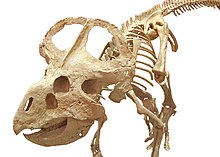
Back Protoceratops Afrikaans Protoceratops AN بروتوسيراتوبس Arabic Protoceratop Catalan Protoceratops CEB Protoceratops Czech Protoceratops German Protoceratops Spanish Protozeratops Basque نیاشاخچهره Persian
| Protoceratops Temporal range: Late Cretaceous, (Campanian) ~
| |
|---|---|

| |
| Mounted P. andrewsi skeleton, Wyoming Dinosaur Center | |
| Scientific classification | |
| Domain: | Eukaryota |
| Kingdom: | Animalia |
| Phylum: | Chordata |
| Clade: | Dinosauria |
| Clade: | †Ornithischia |
| Clade: | †Neornithischia |
| Clade: | †Ceratopsia |
| Clade: | †Coronosauria |
| Family: | †Protoceratopsidae |
| Genus: | †Protoceratops Granger & Gregory, 1923 |
| Type species | |
| †Protoceratops andrewsi Granger & Gregory, 1923
| |
| Other species | |
| |
Protoceratops (/ˌproʊtoʊˈsɛrətɒps/; lit. 'first horned face')[1] is a genus of small protoceratopsid dinosaurs that lived in Asia during the Late Cretaceous, around 75 to 71 million years ago. The genus Protoceratops includes two species: P. andrewsi and the larger P. hellenikorhinus. The former was described in 1923 with fossils from the Mongolian Djadokhta Formation, and the latter in 2001 with fossils from the Chinese Bayan Mandahu Formation. Protoceratops was initially believed to be an ancestor of ankylosaurians and larger ceratopsians, such as Triceratops and relatives, until the discoveries of other protoceratopsids. Populations of P. andrewsi may have evolved into Bagaceratops through anagenesis.
Protoceratops were small ceratopsians, up to 2–2.5 m (6.6–8.2 ft) long and around 62–104 kg (137–229 lb) in body mass. While adults were largely quadrupedal, juveniles had the capacity to walk around bipedally if necessary. They were characterized by a proportionally large skull, short and stiff neck, and neck frill. The frill was likely used for display or intraspecific combat, as well as protection of the neck and anchoring of jaw muscles. A horn-like structure was present over the nose, which varied from a single structure in P. andrewsi to a double, paired structure in P. hellenikorhinus. The "horn" and frill were highly variable in shape and size across individuals of the same species, but there is no evidence of sexual dimorphism. They had a prominent parrot-like beak at the tip of the jaws. P. andrewsi had a pair of cylindrical, blunt teeth near the tip of the upper jaw. The forelimbs had five fingers of which only the first three bore wide and flat unguals. The feet were wide and had four toes with flattened, shovel-like unguals, which would have been useful for digging through the sand. The hindlimbs were longer than the forelimbs. The tail was long and had an enigmatic sail-like structure, which may have been used for display, swimming, or metabolic reasons.
Protoceratops, like many other ceratopsians, were herbivores equipped with prominent jaws and teeth suited for chopping foliage and other plant material. They are thought to have lived in highly sociable groups of mixed ages. They appear to have cared for their young. They laid soft-shelled eggs, a rare occurrence in dinosaurs. During maturation, the skull and neck frill underwent rapid growth. Protoceratops were hunted by Velociraptor, and one particularly famous specimen (the Fighting Dinosaurs) preserves a pair of them locked in combat. Protoceratops used to be characterized as nocturnal because of the large sclerotic ring around the eye, but they are now thought to have been cathemeral (active at dawn and dusk).
- ^ Colbert, Edwin H. (Edwin Harris); Knight, Charles Robert (1951). The dinosaur book: the ruling reptiles and their relatives. New York: McGraw-Hill. p. 153.
© MMXXIII Rich X Search. We shall prevail. All rights reserved. Rich X Search